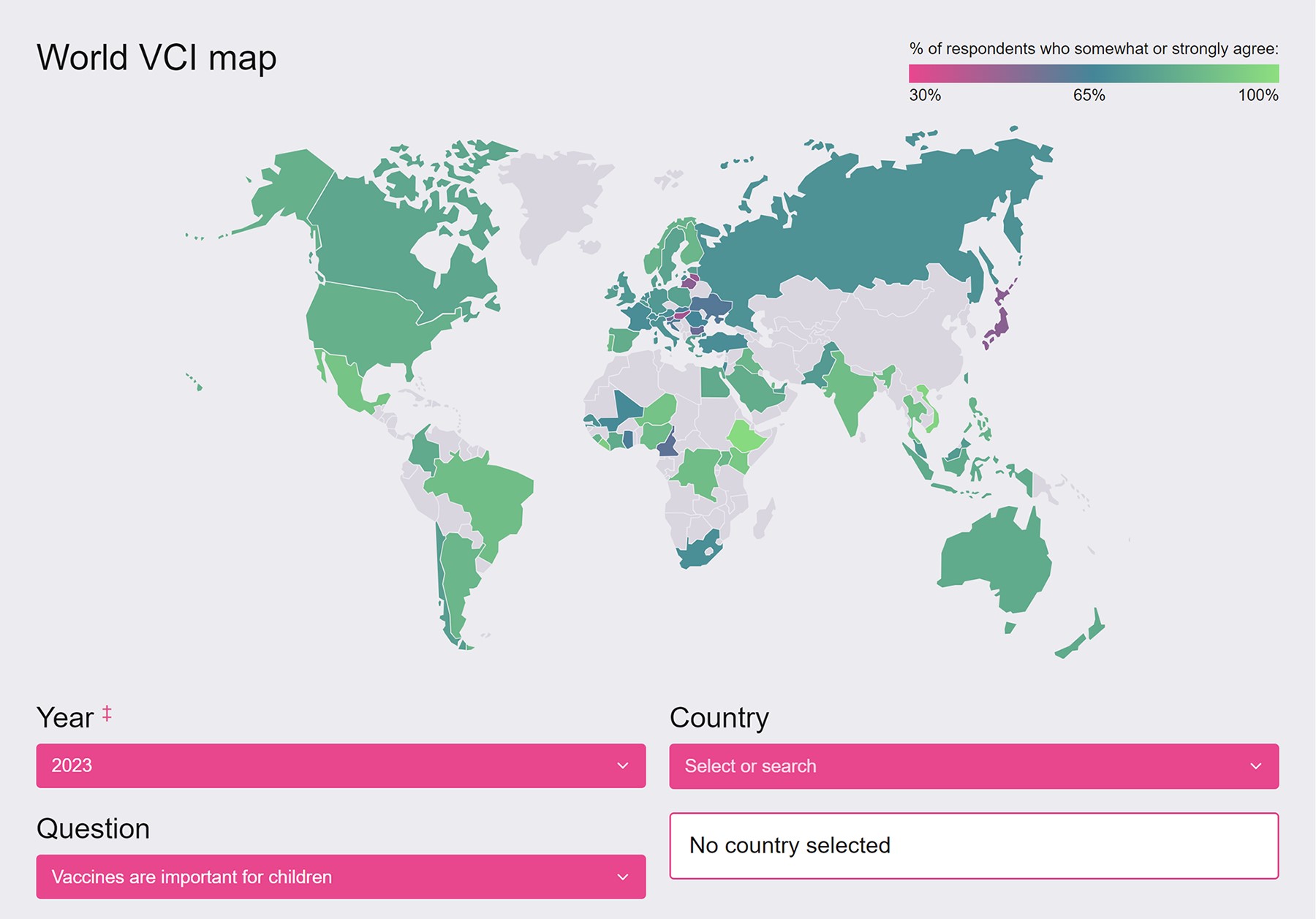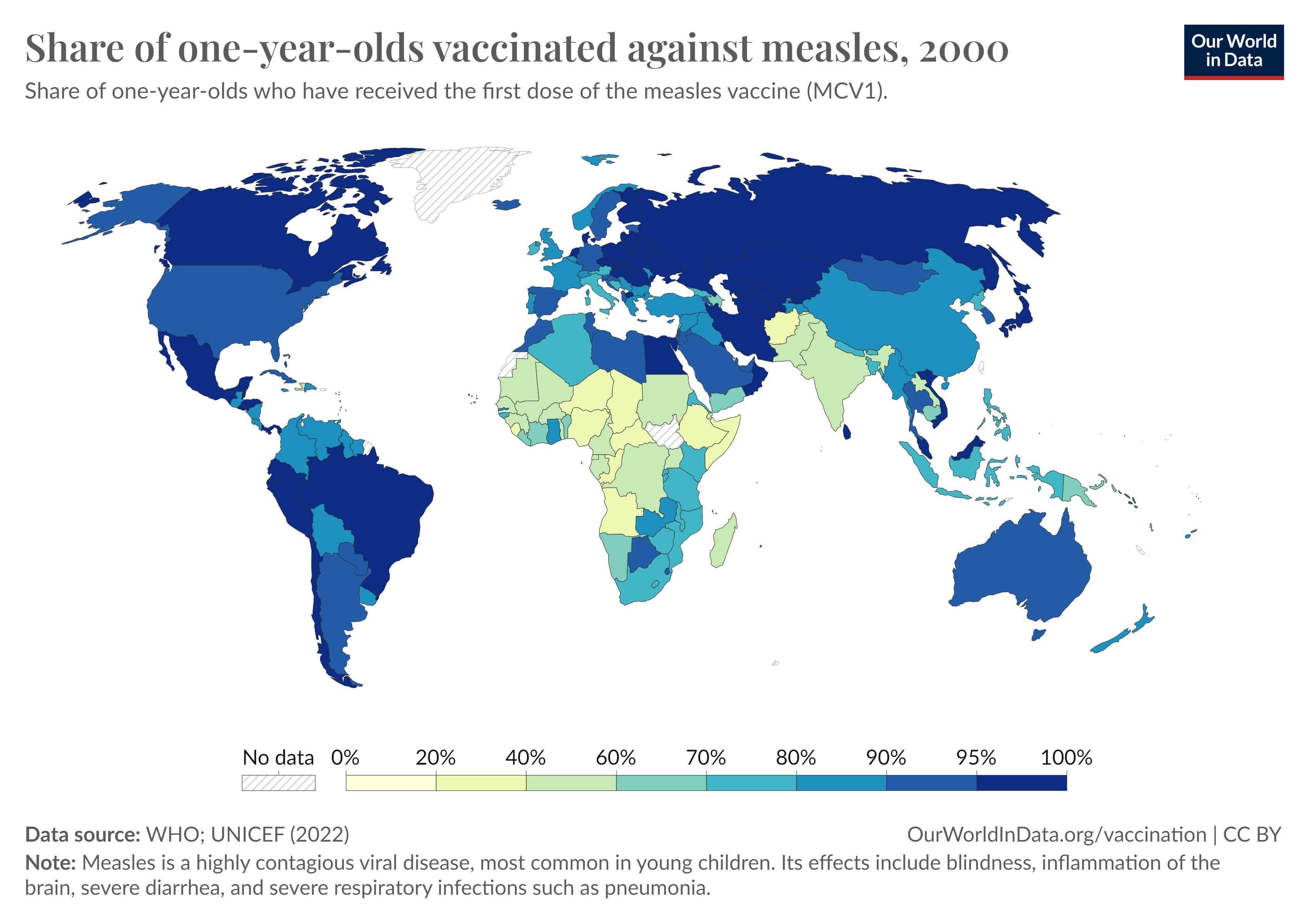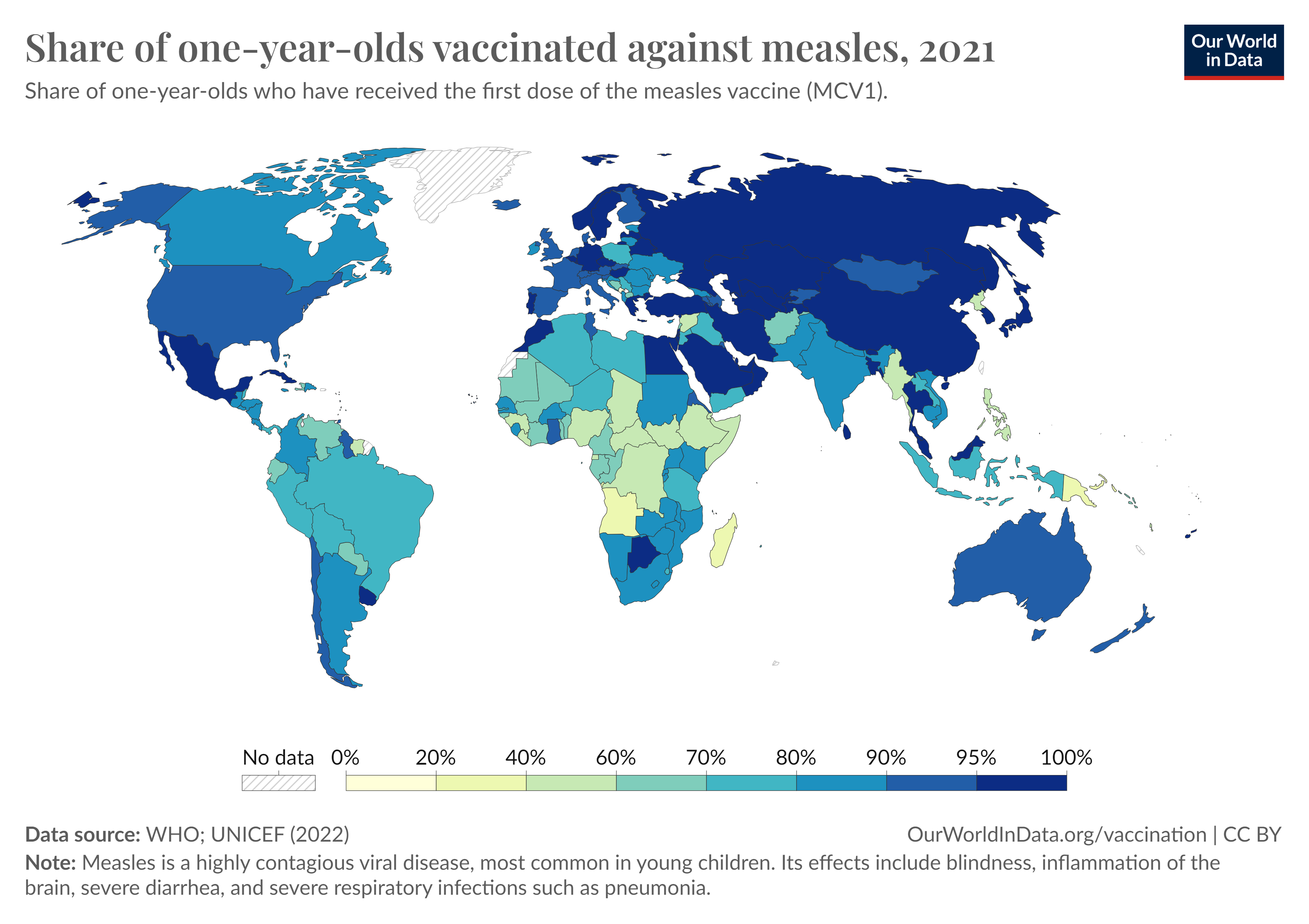April 16, 2024
Measles outbreaks are climbing in numerous countries across the globe, including the U.S. Measles is not a new challenge; effective vaccination for measles has been publicly available since 1963. And yet, countries such as India, with one of the largest populations in the world, has become one of the 37 countries experiencing substantial measles outbreaks.1-7
With vaccination rates on the decline, outbreaks are primarily being driven by unvaccinated travelers going abroad.8 Employers have a renewed opportunity to reactivate programs and efforts put in place for COVID-19 and flu to educate employees on prevention through vaccination while addressing the impact of measles on their workforce.
Key Measles Facts
 |
 |
 |
 |
 |
|---|---|---|---|---|
| Incubation time: It can take 7 to 14 days for symptoms to appear.9 Individuals can transmit the virus 4 days before showing symptoms.8 |
Symptoms: Symptoms include high fever (more than 104° F), cough, runny nose, red, watery eyes followed by white spots in the mouth, and measles rash.9 |
Duration: Measles infections typically last 3 weeks.10,11 Once the rash has appeared, people are typically no longer infectious after four days.13 |
Disease Communicability Measles is very infectious; a single patient with measles can spread the virus to as many as 18 others.8 Once airborne, the virus can remain in the air for 2 hours after an individual with measles has left the area.8 |
Herd Immunity: To eradicate measles through herd immunity, the population needs to be 95% vaccinated for measles.12 |
Why Employers Should Care
No country is exempt from measles, and areas with low immunization rates help keep the virus circulating, increasing the likelihood of outbreaks and putting all unvaccinated and immunocompromised individuals at risk.13 A combination of factors, including delays in preventive care, vaccine shortages brought on by the pandemic and pediatric vaccination rates reaching historic lows, have coalesced to establish the perfect storm for this increase in measles cases globally.13,14
Measles is a highly contagious disease, transferred through touch and respiration.11 In a recent study, a single case of measles can cost $47,479, including direct medical costs (i.e., $1,051 for a single case of measles or more than $25,000 if hospitalized), indirect productivity and public health response costs.15
Vaccination Rates on the Decline
While some people cannot get vaccinated for medical reasons, including those who are immunocompromised, in the U.S., the number of children receiving no vaccinations by the age of 2 is increasing as non-medical exceptions (NMEs) have risen. Vaccine misinformation has increased and found quick transmission on social media.14 According to the London School of Hygiene & Tropical Medicine’s The Vaccine Confidence Project (VCP), Ghana, Japan, Korea, Papua New Guinea and Senegal each saw a decline of more than 33 percentage points in public perception of the importance of childhood vaccinations (Figure 1).14,16, 17

Source: London School of Hygiene & Tropical Medicine’s Vaccine Confidence Project
In the U.S., the Centers for Disease Control and Prevention (CDC) found that for a second year in a row, the national measles, mumps and rubella (MMR) vaccination rate among kindergarten students fell below 95%, to 93%.18 This is noteworthy because 95% is the threshold set to prevent community transmission of measles.18 Furthermore, this figure is the lowest MMR rate reported in almost a decade and leaves approximately 250,000 school-children unvaccinated and unprotected against measles. 19 In England, several cities have measles vaccination rates at 75%, including Birmingham, which experienced an outbreak (Figure 2).4,6 More than 3.4 million children (ages 15 or younger) are not fully vaccinated (many receiving only one dose).27 The UK, which eradicated measles in 2017, currently has 250 cases, and India had more than 12,000 cases in 2023.27,28
In many other countries, including those listed below, the two-dose measles vaccination rates are below the herd immunity 95% threshold: 29

 |
 |
Source: Our World in Data, WHO/UNICEF 2022
NOTE: In order to achieve herd immunity or eradicate measles, a country would need to be at least 95% vaccinated (represented by the deep blue color above).
Progress in Emerging Markets
Global and country initiatives have been building infrastructure and running vaccination campaigns in parts of the world that are not vaccinated. Gavi, the Vaccine Alliance a public–private global health partnership with the goal of increasing access to immunization in poor countries, has worked with countries, non-governmental organizations (NGOs) and employers to make these efforts possible.20 For example, India’s 2021 childhood two-dose measles vaccination coverage is 31.9%.21 Through the Gavi initiative, India is striving for 90% vaccination rates across childhood immunizations, mainly by improving the vaccine supply chain and health care support infrastructure.21,22

How Can Employers Increase Vaccination Rates?
- 1 | Conduct regular, targeted communication campaigns encouraging the use of vaccines to parents, especially those in localities with significant outbreaks of measles, flu or other diseases preventable with vaccines. When planning a campaign, consider including the following action steps:
- Offer preventive treatments like vaccinations at no cost to employees;
- Obtain vaccine safety and effectiveness guidance from reputable institutions such as the World Health Organization (WHO), U.K. National Health Service (NHS), India Ministry of Health and Family Welfare and U.S. CDC
- Educate people about how easily transmissible measles is to loved ones like younger children, aging parents and adults who cannot get vaccinated for medical reasons; and
- Publicize that vaccinations can be obtained at convenient sites of care, including pharmacies, primary care providers, many retail clinics and on-site clinics (if applicable).
- 2 | As part of the communication strategy incorporate culturally conscious messaging tactics:
- Engage community, religious and grassroots leaders who are reputable messengers and can build trust in public health systems and vaccine effectiveness.
- Encourage open and transparent conversations on vaccines by hosting virtual town halls with chief medical officers or other clinical personnel from diverse backgrounds to help vaccine-hesitant individual learn more about the benefits of vaccination. Consider recording these sessions and working with employee resource groups (ERGs) to disseminate them to relevant employee subpopulations.
- Provide communications in multiple languages to effectively deliver information about vaccine efficacy. Provide translated materials and interpreter services to increase overall health literacy.
- 3 | Provide vaccinations at on-site and near-site clinics for employees and dependents.
How Can Employers Prevent the Spread of Communicable Disease to Employees and Customers?
Employers can build off what they learned during the COVID-19 pandemic to address their workforce’s needs. Below are five areas to focus efforts:
 |
Support alternative work arrangements: Allow employees who have potentially been exposed to communicable disease, including measles, to work remotely until they get better. |
|---|---|
 |
Paid leave: Implement and communicate paid sick leave policies and encourage employees to take time off when needed to prevent the spread of disease to other employees or customers and to care for their impacted loved ones. |
 |
Global consistency in immunization: For global consistency efforts, ensure that vaccines are covered by either private health plans or the national/state health care system by working with your broker or consultant partners. WHO has a database that summarizes immunization schedules by region and country. Questions to ask vendor partners include the following:
|
 |
Preparation for travel: Make sure globally mobile employees are aware of and have all necessary vaccines before traveling. |
 |
Leveraging campaigns to promote awareness: Recognize World Immunization Week. This global public health campaign focuses on raising awareness and increasing global immunization rates. It takes place annually during the last week of April. |
Related Content
More Topics
Articles & Guides- 1 | World Health Organization (WHO). Global measles threat continues to grow as another year passes with millions of children unvaccinated. November 16, 2023. https://www.who.int/news/item/16-11-2023-global-measles-threat-continues-to-grow-as-another-year-passes-with-millions-of-children-unvaccinated. Accessed February 12, 2024.
- 2 | Schnirring L. CDC alerts healthcare providers about measles cases. Center for Infectious Disease Research & Policy (CIDRAP). January 25, 2024. https://www.cidrap.umn.edu/measles/cdc-alerts-healthcare-providers-about-measles-cases. Accessed February 12, 2024.
- 3 | Carrero N. Rise in measles cases at Broward elementary school could just be the beginning, doctor says. CBS News. February 18, 2024. https://www.cbsnews.com/miami/news/rise-in-measles-cases-at-broward-elementary-school-could-just-be-the-beginning-doctor-says/. Accessed February 23, 2024.
- 4 | Schnirring L. Measles activity expands rapidly in Europe, Kazakhstan worst affected. CIDRAP. January 23, 2024. https://www.cidrap.umn.edu/measles/measles-activity-expands-rapidly-europe-kazakhstan-worst-affected. Accessed February 12, 2024.
- 5 | Illien N. Swiss hospitality school closes after measles outbreak. Reuters. February 9, 2024. https://www.reuters.com/business/healthcare-pharmaceuticals/swiss-hospitality-school-closes-after-measles-outbreak-2024-02-03/. Accessed February 12, 2024.
- 6 | Roxby P. Alarming 45-fold rise in measles in Europe – WHO. BBC. January 23, 2024. https://www.bbc.com/news/health-68068226. Accessed February 12, 2024.
- 7 | Choi J. Measles outbreak threatens U.S. status of ‘eliminating’ virus. The Hill. March 8, 2024. https://thehill.com/policy/healthcare/4517298-measles-outbreak-us-status-elimination/. Accessed March 11, 2024.
- 8 | Mandavilli A. Following measles outbreaks, officials grow wary of renewed threat. The New York Times. March 21, 2024. https://www.nytimes.com/2024/03/20/health/measles-children-travel.html. Accessed March 22, 2024.
- 9 | Centers for Disease Control and Prevention (CDC). Measles (rubeola): Signs and symptoms. November 5, 2020. https://www.cdc.gov/measles/symptoms/signs-symptoms.html. Accessed March 15, 2024.
- 10 | CDC. Measles (rubeola): Complications of measles. November 5, 2020. https://www.cdc.gov/measles/symptoms/complications.html. Accessed March 15, 2024.
- 11 | Butler C. 'Immune amnesia:' The unusual measles side effect scientists think can drive other epidemics. CBC News. December 2, 2022. https://www.cbc.ca/news/canada/london/immune-amnesia-measles-research-1.6670701. Accessed March 15, 2024.
- 12 | CDC. Measles (rubeola): Vaccine for measles. November 5, 2020. https://www.cdc.gov/measles/vaccination.html. Accessed March 15, 2024.
- 13 | WHO. Measles fact sheet. August 9, 2023. https://www.who.int/news-room/fact-sheets/detail/measles. Accessed February 12, 2024.
- 14 | Gottbrath LW. A worrying sign in the global effort to vaccinate every child. Axios. April 20, 2023. https://www.axios.com/2023/04/20/childhood-vaccines-hesitancy-immunization-unicef. Accessed March 11, 2024.
- 15 | Pike J, Melnick A, Gastañaduy PA, et al. Societal costs of a measles outbreak. Pediatrics. 2021 Apr;147(4):e2020027037. https://www.ncbi.nlm.nih.gov/pmc/articles/PMC9004490/. Accessed March 11, 2024.
- 16 | Nyhan B, Reifler J, Richey S, Freed GL. Effective messages in vaccine promotion: A randomized trial. Pediatrics 2014; 133 (4): e835–e842. https://publications.aap.org/pediatrics/article-abstract/133/4/e835/32713/Effective-Messages-in-Vaccine-Promotion-A?redirectedFrom=fulltext. Accessed March 11, 2024.
- 17 | Hodgson B. Vaccine confidence index map. Vaccine Confidence Project. 2023. https://www.vaccineconfidence.org/vci/map/. Accessed March 11, 2024.
- 18 | Seither R, Yusuf OB, Dramann D, Calhoun K, Mugerwa-Kasujja A, Knighton CL. Morbidity and mortality weekly report (MMWR): Coverage with selected vaccines and exemption from school vaccine requirements among children in kindergarten — United States, 2022–23 school year.CDC. November 10, 2023. https://www.cdc.gov/mmwr/volumes/72/wr/mm7245a2.htm. Accessed February 12, 2024.
- 19 | Williams E, Rudowitz R, Moreno S. Headed back to school in 2023: A look at children’s routine vaccination trends. KFF. July 31, 2023. https://www.kff.org/coronavirus-covid-19/issue-brief/headed-back-to-school-in-2023-a-look-at-childrens-routine-vaccination-trends/. Accessed February 12, 2024.
- 20 | Gavi, the Vaccine Alliance. Measles and measles-rubella vaccine support. August 22, 2023. https://www.gavi.org/types-support/vaccine-support/measles-and-measles-rubella. Accessed March 11, 2024.
- 21 | Ministry of Health & Family Welfare. National Family Health Survey (NFHS-5) 2019-2021. September 2021. https://main.mohfw.gov.in/sites/default/files/NFHS-5_Phase-II_0.pdf. Accessed March 22, 2024.
- 22 | National Health Mission. Immunization. Department of Health & Family Welfare. Ministry of Health & Family Welfare Government of India. March 22, 2024. https://nhm.gov.in/index1.php?lang=1&level=2&sublinkid=824&lid=220. Accessed March 22, 2024.
- 23 | Gavi, the Vaccine Alliance. Donor profile: Toyota Tsusho. June 30, 2023. https://www.gavi.org/investing-gavi/funding/donor-profiles/toyota-tsusho. Accessed March 11, 2024.
- 24 | GSK. GSK and Save the Children renew award-winning partnership, with focus on ‘zero dose’ children who have never received a vaccine. September 14, 2023. https://www.gsk.com/en-gb/media/press-releases/gsk-and-save-the-children-renew-award-winning-partnership/. Accessed March 11, 2024.
- 25 | Healthcare Radius. GSK targets parents of toddlers for vaccination campaign. January 17, 2024. https://www.healthcareradius.in/clinical/vaccination/gsk-targets-parents-of-toddlers-for-vaccination-campaign. Accessed March 11, 2024.
- 26 | Gavi, the Vaccine Alliance. Donor profile: Orange. 2022. https://www.gavi.org/investing-gavi/funding/donor-profiles/orange. Accessed March 11, 2024.
- 27 | Hui S. Millions in the UK are being urged to get vaccinations during a surge in measles cases. AP News. March 27, 2024. https://apnews.com/article/uk-measles-outbreak-mmr-vaccination-rates-5c060634a19b8bf272d0f304e9e0f42d. Accessed March 28, 2024.
- 28 | CNBCTV18. India ranks fourth in global measles outbreak — what's causing it. February 28, 2024. https://www.cnbctv18.com/healthcare/india-recorded-4th-highest-measles-cases-in-second-half-of-2023-whats-the-reason-behind-this-19154271.htm. Accessed March 28, 2024.
- 29 | WHO. The Global health observatory. Measles-containing-vaccine second-dose (MCV2) immunization coverage by the nationally recommended age (%). July 11, 2023. https://www.who.int/data/gho/data/indicators/indicator-details/GHO/measles-containing-vaccine-second-dose-(mcv2)-immunization-coverage-by-the-nationally-recommended-age-(-). Accessed March 27, 2024.
- 30 | ACOEM Podcast – OccPod. Episode 56, COVID-19 updates and measles outbreaks. March 7, 2024. https://open.spotify.com/episode/0MBA7lI4zrPS2V5PMGWonD?si=4c970c90dccd44d6. Accessed March 11, 2024.
- 31 | ACOEM Podcast – OccPod. Episode 53, Vaccinations in the workplace. September 8, 2023. https://open.spotify.com/episode/2K09bnyCXn9eCSY0VNBVoa?si=079ed4b0ab354824. Accessed March 11, 2024.
- 32 | ACOEM Podcast – OccPod. Episode 41, Vaccine side effects and hesitancy. February 8, 2023. https://open.spotify.com/episode/2vacJswZ0m8vAN5mdjdjYT?si=30fdbf08958d4ff4. Accessed March 11, 2024.
This content is for members only. Already a member?
Login
![]()
